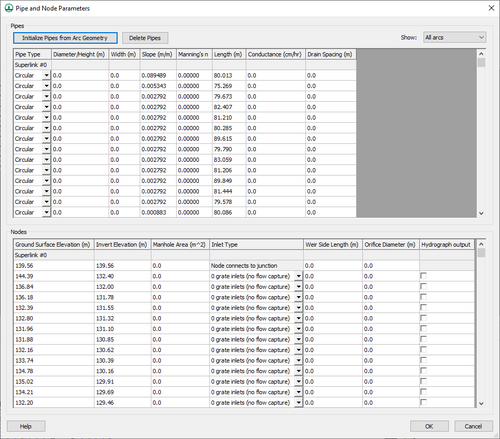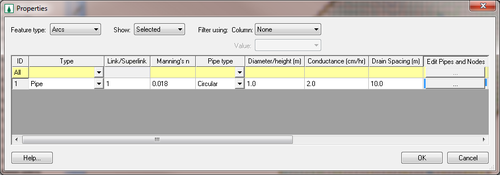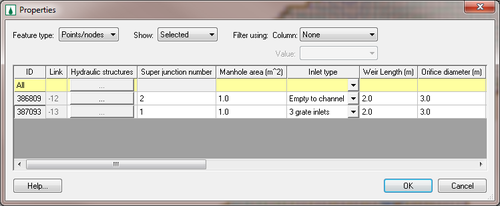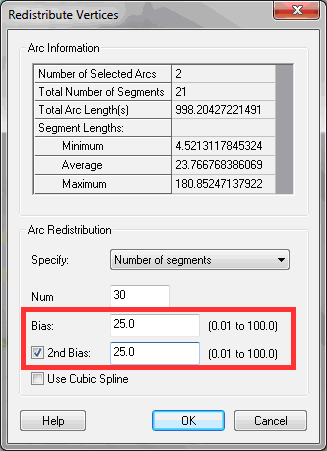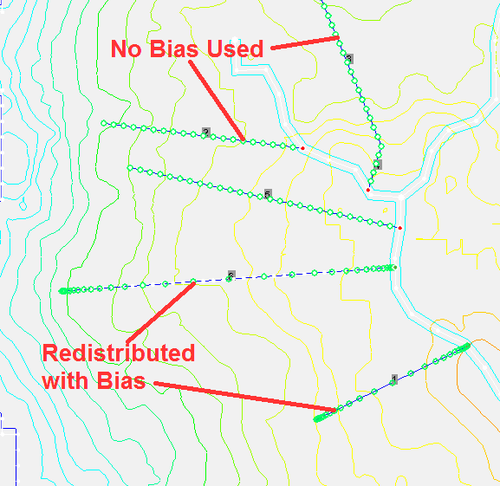WMS:Pipe and Node Parameters
Overview
The GSSHA Pipe and Node Parameters dialog is accessed by selecting one or more feature arcs, going to the GSSHA Feature Arc Properties dialog, and changing the arc type to Pipe. This dialog is used for building and editing the pipes and nodes associated with Super-Links when running a GSSHA Storm and Tile drain simulation.
Help
When running a GSSHA Storm and Tile drain simulation, it is a good idea to add more than one pipe (2 nodes) between Super-Junctions. In WMS, Super-Links are represented as arcs and Super-Junctions are represented by the 2 nodes at the end of each arc. Each link may contain 1 or more pipes and 2 or more nodes. Many of the attributes between Super-Junctions and nodes between Super-Junctions overlap. In WMS, you define nodes along a Super-Link (between Super-Junctions) by adding vertices along an arc. You can redistribute the vertices on the arc using the Redistribute command or you can manually add vertices along an arc using the Create Vertex tool. Normally, you would follow the following steps to define storm or tile drains and their attributes in WMS:
- Create a new GSSHA storm drain coverage and define your storm or tile drain geometry using arcs.
- Define the storm or tile drain attributes for each arc (Super-Link) using the GSSHA Arc Properties dialog.
- Define the storm or tile drain attributes and pipe invert elevations for the nodes at each end of the arcs (Super-Junctions) using the GSSHA Point/Node Properties dialog.
- For each arc (Super-Link), redistribute the vertices along the arc using the redistribute vertices command and/or manually add vertices along each arc. The spacing and number of vertices on an arc define the pipes and nodes on the arc and the lengths and slopes of the pipes.
- Define the attributes of the pipes and nodes for each arc (Super-Link) by going to the GSSHA Arc Properties dialog and clicking on the Edit Pipes and Nodes button.
- From the Pipe and Node Parameters dialog, you can Initialize your Pipes from the Arc Geometry. Clicking on this button creates a pipe for each arc segment on your selected arc and creates a node for each node or vertex on the arc. Attributes associated with the Super-Link (arc) and Super-Junctions (arc nodes) are transferred to the generated pipes and nodes, but you are free to edit these transferred data values. Node ground surface elevations are extracted from the 2D grid elevations at the location of each node or vertex on the selected arc. These pipes and nodes are written to the GSSHA Storm Pipe Network (*.spn) file when the GSSHA project is written. It is important to define pipe and node parameters for all the pipe arcs in your storm or tile drain network. Deleting the pipes will delete the pipes and nodes from your arc, but you should re-initialize the pipes from the arc geometry after making any changes that need to be made or WMS may not write the correct pipe and node attributes for the selected arc.
Refer to the GSSHA Subsurface Tile and Storm Drain tutorial for more information about how to setup a storm or tile drain model.
Tools for Editing GSSHA Storm and Tile Drain Data
WMS 10.0 and later versions have several specialized tools for editing storm and tile drain data. These tools are described in this section.
Varied node distribution on an arc
The distribution of vertices (nodes) along an arc (superlink) in the GSSHA Storm Drain coverage is important in the storm/tile drain model used by GSSHA. You should space nodes closely near junctions and farther apart toward the center of the superlink. WMS has an option under the Redistribute option for feature arcs that allows you to define a 2nd bias. Each of the bias values defines the ratio of spacing between vertices at the center of the arc and at the middle of the arc. Use the same bias value along with a specified vertex spacing or a number of vertex segments to define vertices close together at the ends and far apart at the center of the superlink. See the images below.
GSSHA Storm Drain coverage
In WMS 10.0 and later, Pipe arc types are no longer defined in a GSSHA coverage. They are defined in a GSSHA Storm Drain coverage so pipes drawn inside of WMS do not impact stream elevations in the GSSHA coverage.
- File:GsshaStormDrainCoverageFig1.pngThe GSSHA Storm Drain coverage has been separated from the GSSHA Coverage
If you have an existing GSSHA project with pipe arcs in a GSSHA coverage, WMS converts these arcs to generic arcs in the GSSHA coverage and copies the pipes into a GSSHA Storm Drain coverage. This transition should work seamlessly, without needing to do any work. Existing files with a GSSHA storm drain coverage can be read and should be able to be re-written and run in GSSHA from the WMS interface. You may want to delete the generic arcs that were pipes and are left in the GSSHA coverage, or you can leave them there. WMS does not put up any messages when converting a file from the single coverage to the GSSHA and GSSHA Storm Drain coverage model to avoid annoying users.
| [hide] WMS – Watershed Modeling System | ||
|---|---|---|
| Modules: | Terrain Data • Drainage • Map • Hydrologic Modeling • River • GIS • 2D Grid • 2D Scatter |  |
| Models: | CE-QUAL-W2 • GSSHA • HEC-1 • HEC-HMS • HEC-RAS • HSPF • MODRAT • NSS • OC Hydrograph • OC Rational • Rational • River Tools • Storm Drain • SMPDBK • SWMM • TR-20 • TR-55 | |
| Toolbars: | Modules • Macros • Units • Digitize • Static Tools • Dynamic Tools • Drawing • Get Data Tools | |
| Aquaveo | ||
